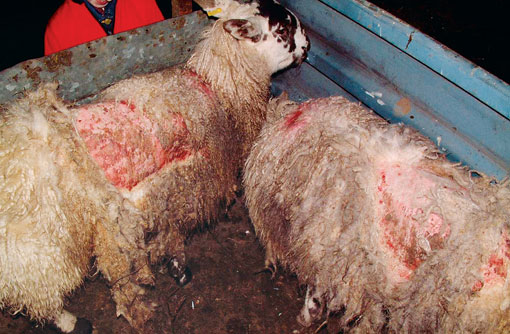Sheep scab eradication requires teamwork

Sheep scab eradication requires a team effort. Debbie James speaks to one farmer driving a group of Welsh producers to successfully keep more than 10,000 ewes scab free.
A group of 20 upland lamb producers are demonstrating that a collective approach to sheep scab eradication can work.
Twelve months ago, neighbouring farmers in the Machynlleth area of mid-Wales agreed to work together to control a problem that was decimating their productivity.
Their goal was to co-ordinate preventative sheep scab treatment and biosecurity while minimising the risk of its reintroduction.
During this time the farmers have shared information on their treatment plans and treated their flocks at the same time of the year – in January.
Brothers Dafydd and John Parry Jones, who led this group approach, have been free of sheep scab in the past year. As organic producers, they inject with a 60-day persistency injectable moxidectin product instead of dipping.
They admit there are still cases in the region, but overall the group – which runs about 10,000 ewes – has been successful in containing outbreaks.
“Before we set this group up we had been battling and treating sheep scab like everyone else and felt that something needed to be done. It seems to be working,” says Dafydd.
“We have had good results and are already working together by discussing treatment plans for next year.”
The Jones’ run similar enterprises on neighbouring farms and have 2,000 organic ewes between them.
The productivity and welfare implications of sheep scab can be very serious and primary responsibility for controlling the disease still falls on the farmer.
And part of the problem when controlling scab is the window of opportunity for scab mites between the traditional use of OP dips by some farmers in the autumn, and the use of injectable scab treatments by others pre-lambing.
Dafydd admits upland farmers don’t have a history of working together, but says sheep scab was a disease that could not be tackled in isolation. It is especially prevalent in upland regions because flocks are frequently moved around for wintering or new stock is brought on to the farm.
“With all the movements there is a real risk scab will come in. It is one part of the flock health plan that you can’t control alone, you have to work with your neighbours to try to sort it out,” adds Dafydd.
“We don’t buy anything in or winter away from the farm, but if we didn’t treat at the same time as everyone else, we would become part of the problem.”
What is the group control strategy?
The farmers in the group all treat in January, just before lambing. They opted for this period, and not the autumn one, because the withdrawal period on sheep dips would not suit a fat lamb system.
There were other reasons, too – by January most of the fat lambs have been sold and scanning, and a potential vector for flock-to-flock transmission of scab mites, has been done.
“Only the core flock is on the farm,” explains Dafydd. “We inject with a view to being clean when the lambs arrive in the early spring, but we would also inject in September if there was a problem in the area.”
But different approaches will suit different systems. “There isn’t one system to suit an area; it is up to individual farmers working together to find the right timings,” says Dafydd.
The financial impact of scab
Not only is sheep scab an animal health and welfare problem but it can jeopardise contracts with buyers. The Jones brothers have a contract to supply Waitrose and agree to supply a fixed number of lambs weekly.
“For farmers like us who commit lambs to be sold, it can be very damaging if there is scab in the flock. You can’t sell lambs if they have scab – it’s similar to being under movement restrictions for bovine TB,” explains Dafydd.
“If you get an outbreak of scab and can’t supply your buyer, he could decide to no longer deal with you because you can’t meet the terms of your contract. Lamb markets are good at the moment, but we have to look after them.”
In the past, scab has cost him the organic premium on his lambs because he has been forced to sell them into the conventional market.
The lamb producers in the Machynlleth scab eradication group hope that by taking matters into their own hands and taking a bottom-up approach to the problem, it could prompt top-down intervention, too.
“It would be helpful to have a national co-ordinator, someone who understands the problem well,” says Dafydd. “A co-ordinator could get people talking and manage the control work in other areas.”
Find out more
To find out about the latest control methods against parasites, go to the seminar area at NSA Sheep 2012 at 11am, where Lesley Stubbings will discuss the latest SCOPs guidelines. In addition, attend the flock health planning area, where Novartis Animal Health is holding several workshops, including a pour on demonstration, and providing advice on preventing drug resistance.
